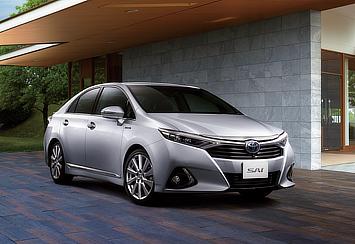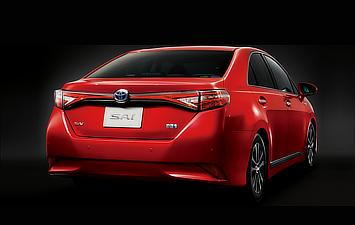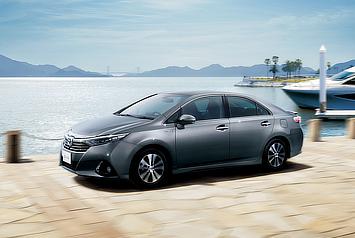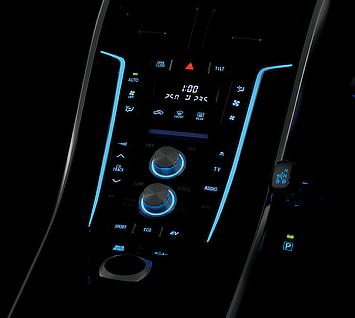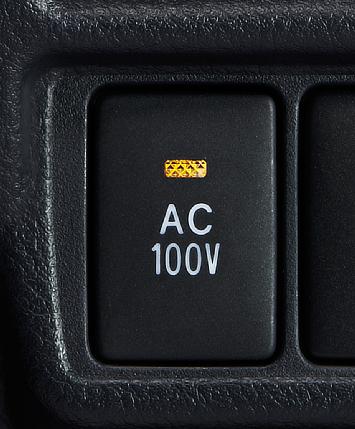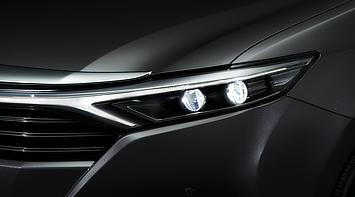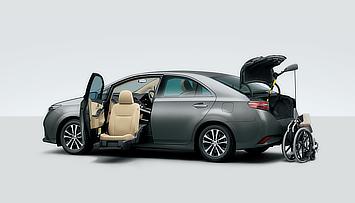Aug. 29, 2013
TMC Launches Redesigned 'Sai' Hybrid Sedan in Japan
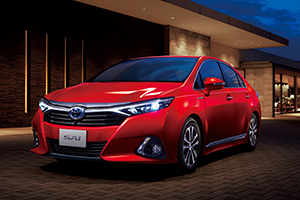
Sai G grade (with options)
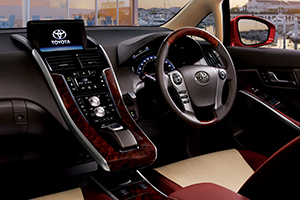
Sai G grade (with options)
The Sai was first launched in 2009, with the name and concept taken from two different Chinese written characters (both pronounced "sai") meaning talent and coloration. Both the interior and exterior have been revamped with ultra-wide headlamps and other features to evoke greater luxuriousness and modernity, with the updated styling appealing to consumers of all ages. Improved body rigidity and aerodynamics provides superior, lighter handling as well as better ride.
A new level of environment-friendliness has been achieved with the new Sai achieving fuel economy of 22.4 km/L and C02 emissions of 104 g/km under the Japanese Ministry of Land, Infrastructure, Transport and Tourism JC08 test cycle. Moreover, use of recycled materials has also been greatly expanded with approximately 80 percent of the interior surface area made from Ecological Plastic1.
With the Sai, TMC has achieved its target of 20 percent usage of Ecological Plastic and recycled resin materials for resin parts in vehicles two years ahead of schedule. This target was detailed in the Toyota Recycle Vision2, TMC's vehicle environmental technology guideline stipulated under the Fifth Toyota Environmental Action Plan2 (a five-year plan covering 2011-2015).
The Sai is thus aimed to stand at the forefront of environment-friendliness.
Some descriptions apply to select model-grades/versions only.
Monthly sales target for Japan: 2,000 units
Assembly Plant: Miyata Plant, Toyota Motor Kyushu, Inc.
| Grade | Hybrid System | Driveline | Price* | |
| S | THS II with reduction gear | Front-wheel drive | 3,210,000 yen | |
| C Package | 3,310,000 yen | |||
| G | 3,820,000 yen | |||
| A Package | 4,210,000 yen | |||
| *Includes consumption tax, does not include recycling fees and differs in Hokkaido and Okinawa | ||||
Advanced, Luxurious Interior and Exterior
Exterior
The Sai exterior was completely overhauled for an advanced, modern look. Character lines flow seamlessly from the front emblem, through the sides, and to the rear, for a smart, sleek form.
Ultra-wide headlamps stretching across almost the entire front mask highlight the bold, intrepid design. Powerful LED beams are projected forward from the headlamps extending across both sides to create a front view unique to the Sai. Thick horizontal lines, stacked from the hood down to the bumper, further accent the front.
A broad feeling of stability is conveyed by the rear view which flows smoothly from the rear emblem to the combination tail lamps. Rear reflectors, placed at the extreme bottom of each side of the bumper, further emphasize vehicle stability and result in a unique configuration that is easily identifiable.
The standard 16-inch aluminum wheels feature a combination of machine-cut highlights and black paintwork to bring the surrounding bodywork into stark relief, while emphasizing the sporty look of the wheels. Available as options3, 18-inch aluminum wheels combine clean machine-cuts and metallic gray paintwork with multiple spokes that underscore the vehicle's sense of speed.
Three new exterior colors—Red Mica Metallic, Grey Mica Metallic, Clear Stream Metallic—bring the total available colors to seven.
Interior
The dashboard, including the center console and instrument cluster, has been redesigned with wood-grain and metal-plating accents to create a modern and luxurious interior.
The luxurious look is further refined with a center console that extends seamlessly from the video display to the console box.
The cockpit clearly delineates between display and command zones, and also incorporates the refined and evolutionary Remote Touch control system for enhanced elegance and user-convenience.
The sophisticated interior features stitched fabric on the shifter knob, armrests and gauge hood, as well as audio dials etched from aluminum.
Switches and instrument gauges are illuminated with a clear blue4, with the glow of the metal-plated center console moldings also providing cabin illumination.
There are three colors (four types) of interior to choose from including a new gentle, relaxing, and warm red color, inspired by the Japanese akane plant.
Vastly Improved Basic Performance
The use of reinforced sound insulation material, sound-reducing glass, and a refined engine mount reduces unwanted noise within the cabin to an extreme low, allowing quietness surpassing other typical high-end models of the large sedan class.
Aero-stabilizing fins, performance dampers3 and additional spot-welding points combine to deliver a more comfortable ride and more stable handling.
Hybrid-system control technology was updated to achieve fuel economy of 22.4 km/L and CO2 emissions of 104 g/km under the Japanese Ministry of Land, Infrastructure, Transport and Tourism (MLIT) JC08 test cycle. The vehicle also exceeds the MLIT fuel efficiency standard for 2015 by 20 percent and achieves emissions levels 75 percent lower than the 2005 standards under the MLIT's Approval System for Low-Emission Vehicles, making it eligible for tax reductions under the Japanese government's tax incentive program for environment-friendly vehicles.
The new Sai also features a new Sports Drive mode. A slight press of the accelerator results in a powerful increase in speed which, coupled with an adjustment in power steering controls, provides greater driving response.
Cutting-Edge Environmental Technology
The use of recycled resin materials has been greatly expanded to include usage in a total of approximately 100 parts, including the lower grille, the underfloor cover, and even in the pigments used in the interior coloring (for which using recycled materials has traditionally been difficult). Eighty percent of the interior surface area is now made from plant-based Ecological Plastic. The weight of recycled resin materials has been increased by approximately a factor of three, leading to an even more environment-friendly car.
Cutting-edge Equipment That Anticipates the Future
Now available is a cutting-edge, 10-speaker SD Navigation system5. With a microSD card slot, Blu-ray compatibility and improved features (such as two USB slots instead of one), the Sai seeks to meet the ever-changing needs of consumers.
Available as an option3, an electrical socket for accessories (AC 100 V, 1500 W) can enable the use of the hybrid system battery as a power supply in the event of an emergency.
| Length/Width/Height | 4,695 mm / 1,770 mm / 1,485 mm | |
| Wheelbase | 2,700 mm | |
| Engine | Model | 2AZ-FXE |
| Displacement | 2,362 cc | |
| Maximum output | 110 kW [150 PS] / 6,000 rpm | |
| Maximum torque | 187 N-m [19.1 kgf-m] / 4,400 rpm | |
| Motor | Maximum output | 105 kW [143 PS] |
| Maximum torque | 270 N-m [27.5 kgf-m] | |
| Complete system* | Maximum output | 140 kW [190 PS] |
| Battery | Nickel-metal hydride | |
| Fuel efficiency | Under JC08 test cycle | 22.4 km/L |
| *Using both engine power and electric motor power (based on TMC calculations) | ||
| Model | Grade | Hybrid system | Driveline | Price* |
| Welcab Lift-up Front Passenger Seat (Type A) |
S C Package |
THS II with reduction gear | Front-wheel drive | 3,860,000 yen |
| G | 3,986,000 yen | |||
| Welcab Lift-up Front Passenger Seat (Type B) |
S C Package |
3,933,000 yen | ||
| G | 4,059,000 yen | |||
| *Differs in Hokkaido and Okinawa and excludes recycling fees; exempt from consumption taxes | ||||
2Toyota established its first Toyota Environmental Action Plan in 1993, as a means of implementing concrete initiatives that reflect the policy expressed in the 1992 Toyota Earth Charter. As part of the Third Toyota Environmental Action Plan (2001-2005), the Toyota Recycle Vision was established in 2003.
3Available as an option in the G-grade and G-grade "A package" models
4Standard in G-grade and G-grade "A package" models
5Standard in G-grade and G-grade "A package" models; available as an option in S-grade and S-grade "C package" models
6Specially equipped vehicles to assist the needs of the elderly, the disabled, and others who require extra care or support






